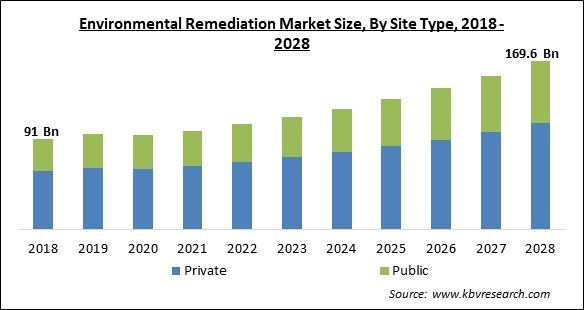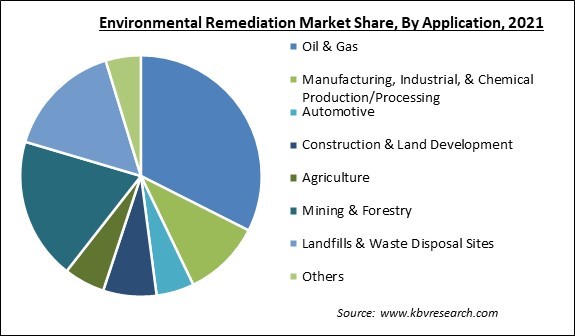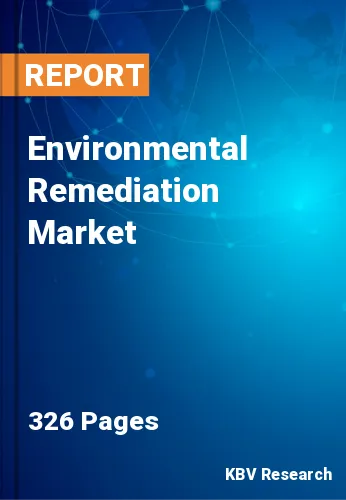The Global Environmental Remediation Market size is expected to reach $169.6 billion by 2028, rising at a market growth of 8.1% CAGR during the forecast period.
Environmental remediation removes pollutants or toxins from water (including ground and surface water) and soil. These waste materials are eliminated to protect human health and restore the ecosystem. Brownfield sites are remediated for reconstruction or to return them to their natural form. The cleanup of sites that have been exploited for hazardous waste disposal presents a particular difficulty. Many of these so-called Superfund sites are governed by federal rules by the Environmental Protection Agency (EPA).

The EPA organizes the cleaning of these sites, mandating that the responsible party either execute the cleanup themselves or compensate the government for EPA-led cleanups. Environmental remediation is heavily regulated and subject to a variety of regulatory standards, which are often based on risk assessments of human health and the environment.
Various environmental media, including soil, sediment, groundwater, and surface water, undergo environmental rehabilitation. Soil remediation covers topsoil, subsoil, and sediment, whereas water remediation encompasses both groundwater and surface water. Depending on the nature and degree of the contamination, soil and water cleanup may be undertaken separately or simultaneously.
Remediation of water is the removal of pollutants from water. Surface water in lakes, streams, and rivers can be polluted by pollutants dumped directly into the water or runoff from the land. Groundwater, the subterranean water that permeates porous material, may get contaminated by toxins that seep through the soil and silt above it. Many regions have experienced groundwater contamination as a result of waste products improperly disposed of or kept on land, where they percolated into the soil and were subsequently transported into the groundwater. The contamination of groundwater has also been caused by industrial activities such as mining and oil and natural gas extraction.
The negative consequences of COVID-19 are already apparent, and it has had a significant influence on environmental cleanup efforts in 2020. Exports and imports, manufacturing, tourism, and the financial industry have all sustained significant harm. The emergence of the virus has added risk factors to the already slow economic growth. According to several international organizations, the current economic climate is the most challenging since the financial crisis. Since the pandemic, restrictions on imports and exports have significantly impacted environmental cleanup, since consumer consumption and demand patterns have shifted. Many businesses have delayed or cancelled environmental rehabilitation orders, resulting in a decline in demand for environmental remediation services at damaged oil field sites.
Lightly regulated and uncontrolled emissions from industrial operations, as well as the disposal and management of wastes, especially hazardous industrial wastes, are key contributors to environmental damage, including prior land and water pollution problems. Due to the maturity of industrial operations and laws, it is not expected that land and water pollution will rise significantly in the future in the majority of industrialized nations. Regulations and their enforcement are major drivers of remediation work; hence, adjustments or projected shifts in regulatory emphasis will have a substantial influence on demand patterns for remediation services.
In recent years, new oxidation processes that do not produce sludge have shown to be highly successful at cleaning contaminated water and wastewater. Using nanoparticles for remediation, the pan-remediation approach speeds up the procedures of finding and eliminating environmental contaminants. Using nanomaterials and analytical techniques, inexpensive, user-friendly, and tiny devices for the detection of a range of environmental contaminants are created.
Moving hazardous or toxic waste during land redevelopment and restoration services requires a large number of bulk materials handling machines. These machines are necessary to transfer the waste. Even when purchased on a rental basis, this equipment, which includes, among other things, excavators, loaders, dumpers, and trucks, has a relatively high acquisition cost. As a result, finishing a cleanup project will demand a significant financial investment in the auxiliary but very important equipment.
By Site Type, the Environmental Remediation Market is classified into Private and Public. The public segment registered a significant revenue share in the environmental remediation market in 2021. It is because about 80 percent of the wastewater produced across the world is released back into the environment, where it is mainly untreated and contributes to the pollution of waterways such as rivers, lakes, and seas. The well-being is being put in jeopardy as a direct result of the pervasive problem of water contamination.

Based on the Technology, the Environmental Remediation Market is segmented into Soil Washing, Chemical Treatment, Bioremediation, Electrokinetic Remediation, Excavation, Permeable Reactive Barriers, In-situ Grouting & In-situ Vitrification, Phytoremediation, Pump and Treat, Soil Vapor Extraction, and Thermal Treatment. The chemical treatment segment recorded a substantial revenue share in the environmental remediation market in 2021. It is because chemical remediation is an in-situ method that extracts contaminants from polluted material using chemicals. Chemical remediation techniques can keep cleanup costs low since they can be undertaken on-site, eliminating the need to transfer soil or water off-site for treatment; hence, they have a rapid growth rate.
On the basis of Environmental Medium, the Environmental Remediation Market is divided into Soil and Groundwater. The groundwater segment recorded a substantial revenue share in the environmental remediation market in 2021. The pollution of groundwater happens when man-made substances such as gasoline, oil, road salts, and chemicals reach the groundwater through the soil, rendering it contaminated and unfit for human consumption. There are numerous inorganics, physical, and organic compounds as well as bacterial and radioactive contaminants in groundwater.
Based on the Application, the Environmental Remediation Market is bifurcated into Mining and Forestry, Oil & Gas, Agriculture, Automotive, Landfills, and Waste Disposal Sites, Manufacturing, Industrial, and Chemical Production/Processing, and Construction and Land Development. The mining and forestry segment witnessed a substantial revenue share in the environmental remediation market in 2021. Cleanup and restoration of sites comprising regions that were once accustomed mine coal or hard rock ore containing metals like gold or copper or other resources such as phosphorus face distinct problems.
| Report Attribute | Details |
|---|---|
| Market size value in 2021 | USD 99.4 Billion |
| Market size forecast in 2028 | USD 169.6 Billion |
| Base Year | 2021 |
| Historical Period | 2018 to 2020 |
| Forecast Period | 2022 to 2028 |
| Revenue Growth Rate | CAGR of 8.1% from 2022 to 2028 |
| Number of Pages | 326 |
| Number of Tables | 549 |
| Report coverage | Market Trends, Revenue Estimation and Forecast, Segmentation Analysis, Regional and Country Breakdown, Companies Strategic Developments, Company Profiling |
| Segments covered | Site Type, Technology, Environment Medium, Application, Region |
| Country scope | US, Canada, Mexico, Germany, UK, France, Russia, Spain, Italy, China, Japan, India, South Korea, Singapore, Malaysia, Brazil, Argentina, UAE, Saudi Arabia, South Africa, Nigeria |
| Growth Drivers |
|
| Restraints |
|
Region-wise, the Environmental Remediation Market is analyzed across North America, Europe, Asia Pacific, and LAMEA. The Asia Pacific segment garnered a promising growth rate in the environmental remediation market in 2021. These factors are anticipated to exacerbate environmental difficulties and will contribute to the expansion of the environmental remediation market in Asia-Pacific. In mining and forestry applications in the region, the use of environmental remediation has increased due to the extensive mining of coal and other minerals, which discharges volatile organic pollutants into the environment.
Free Valuable Insights: Global Environmental Remediation Market size to reach USD 169.6 Billion by 2028
The market research report covers the analysis of key stake holders of the market. Key companies profiled in the report include WSP Global, Inc. (Golder Associates), Clean Harbors, Inc., AECOM Corporation, Stantec, Inc., HDR, Inc., Tetra Tech, Inc., Jacobs Engineering Group Inc., DEME NV and BRISEA Group, Inc.
By Site Type
By Technology
By Environment Medium
By Application
By Geography
The global Environmental Remediation Market size is expected to reach $169.6 billion by 2028.
The regulatory framework is the foundation of the market are driving the market in coming years, however, Expensive Equipment of The Remediation Process restraints the growth of the market.
WSP Global, Inc. (Golder Associates), Clean Harbors, Inc., AECOM Corporation, Stantec, Inc., HDR, Inc., Tetra Tech, Inc., Jacobs Engineering Group Inc., DEME NV and BRISEA Group, Inc.
The Soil market is generating high revenue in the Global Environmental Remediation Market by Environment Medium in 2021; thereby, achieving a market value of $115.8 billion by 2028.
The Private market is leading the Global Environmental Remediation Market by Site Type in 2021; thereby, achieving a market value of $107.1 billion by 2028.
The North America market dominated the Global Environmental Remediation Market by Region in 2021; thereby, achieving a market value of $60.9 billion by 2028.
Our team of dedicated experts can provide you with attractive expansion opportunities for your business.

